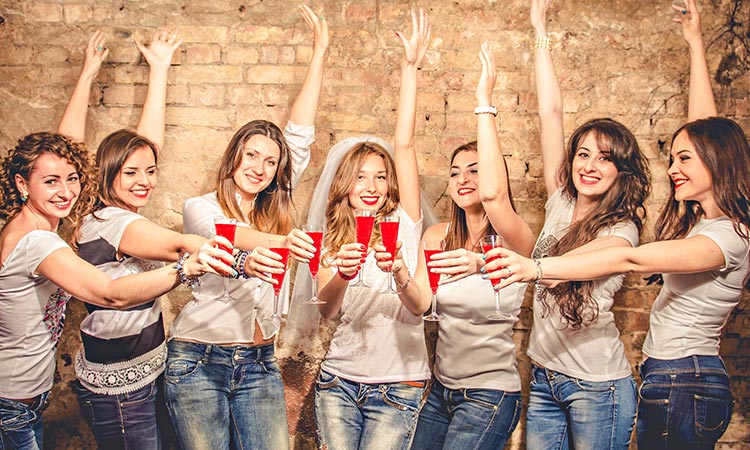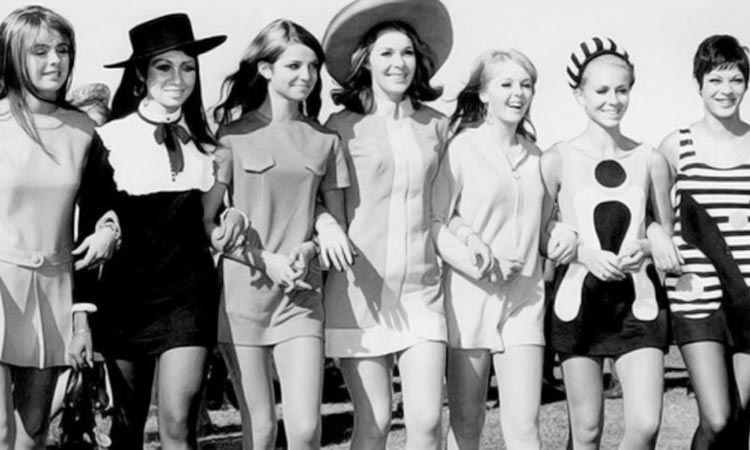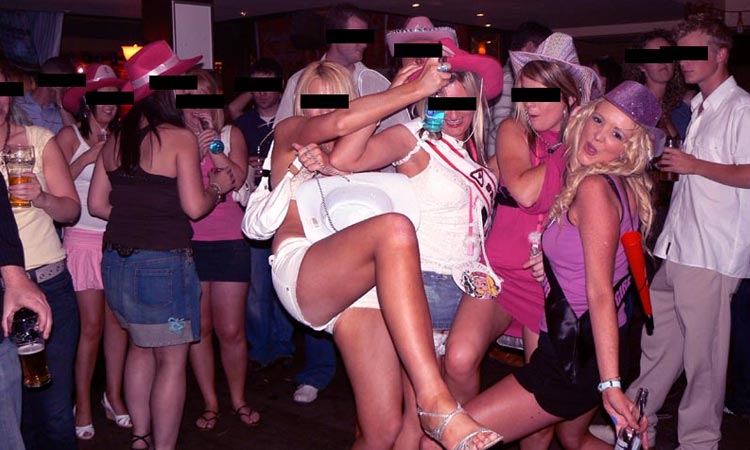As we speak, girls across the land are either planning or getting ready to head off and celebrate what would be their best friend’s last night of freedom. It has become an essential pre-wedding ritual for brides-to-be to get together with her girls and celebrate, be that here or across the channel into Europe. Yet, many do not know how the hen do came about, or how it has evolved over the years into what we know today. With that we have collaborated with Sheila Young, who published a paper on the history of the hen do, to give you a run through of just what the whole thing is all about:
Author: Dr. Sheila Young Phd.
Career academic, Dr. Sheila Young has studies and gained qualifications in a number of chosen fields from Scottish Studies to Zoology. However it was her Phd research and paper on the pre-wedding rituals of women over the years which she gained notoriety for in 2016. Sheila is somewhat of an expert on the hen do, and the history behind it all.
As a former nomad, Sheila is also no stranger to travelling to far flung parts of the globe having visited and taught English to locals in the Netherlands, Australia, Thailand and New Zealand before returning to the UK in 2000. Upon her return, this is where she started her own business offering inter-cultural training.
As you’re making your list of who to invite, planning where to go and what to do (all with the help of Last Night of Freedom, of course) you might be wondering where it all came from? Very little has been written about how the end of single life was celebrated before the 20th century, however, it is likely that there has always been some form of ceremony marking the transition from being single, to being married. In the past, life cycle changes (such as birth, marriage and death) were always considered very dangerous periods for the person/people going through them. As a result, special rituals, which we call rites of passage, were created to help the person navigate these difficult periods safely. It is hard for us to imagine this now, but even as recently as our great-great-grandparent’s time there was much for the bride-to-be to be afraid of in the run-up to her wedding. Sayings such as ‘marry in May, and you’ll rue (regret) the day’ or ‘three times a bridesmaid, never a bride’ are either not known now, or simply disregarded as fears relating to another time and place. However, in the past they were taken seriously, since no one wanted to start off their married life with bad luck. Marrying in May was avoided like the plague, and a single woman might think twice if asked to be a bridesmaid for the third time. Today it might be considered ‘traditional’ for the bride to wear ‘something old, something new, something borrowed, something blue’, whereas in the past failure to do so was unthinkable. Meeting a funeral party on the way to church or on the way home was considered a bad omen, as was being the first couple to be married by a new minister/vicar. Indeed, I could fill an entire page with tales of what would bring either good or bad luck to the bride and groom and the rituals which would offer protection or counteract the bad luck.
 Old school hen party
Old school hen partyThe hen party as we know it, has only been called a hen party since around the 1960s. Before that, there were a variety of workplace rituals, called a variety of names, (depending on where you lived in the UK), such as ‘ribbon girl’, ‘pay off’, ‘taking out’, ‘jumping the chanty’, and the ‘bride’s ritual’. It is uncertain when these rituals arose, but they have been in existence in the factories and offices of Great Britain for at least a century. The term ‘hen party’ is first heard of in America in the late 19thcentury, and originally had nothing to do with weddings. Hen parties were the main social event of the week for middle and upper class women, who would meet in each other’s homes, play a game of cards, and have afternoon tea (and occasionally a glass or two of Champagne). This craze found its way to Britain in the early 20th century, gradually waning around the time of the Second World War. The War saw the beginning of massive social change for women in Britain. They had, after all, kept the country running while the men were away fighting – running farms, working in munitions factories, and generally doing jobs normally associated with men. Having experienced a degree of freedom and equality during the war years many women had no desire to return to the traditional roles they had had before the war. Times had changed and British society was gradually becoming more equal. The days of hen parties in the afternoon were over. The name, however, remained but it became used simply to describe any all-female get together.
And while we are talking about the name – it seems to attract a lot of attention from journalists. They write that it is insulting to women, especially when it is compared to the male equivalent – the stag party. They argue that ‘stag’ conjures up images of individuality, strength, majesty and virility, whereas ‘hen’ elicits thoughts of collectively, stupidity, clucking, breeding and mothering, very different images to that of the stag. In fact, on closer examination the word ‘hen’ seems to have been derived from the word ‘hinnie’ or ‘hennie’, meaning ‘honey’ and therefore has nothing to do with our two legged, feathered friends at all. ‘Hen’ is still used in certain parts of the UK, for example, Glasgow, as a term of endearment. Once again, the word derives not from birds but from honey.
 A modern day hen party celebration
A modern day hen party celebrationWhen you take part in your hen party, with the help of Last Night of Freedom, you are continuing an age old tradition of celebrating your final days or weeks as a single person with your closest friends and family. The switch from single to married may not seem such a big deal these days but in the past it certainly was, especially for a woman. Until the advent of reliable contraception in the 1960s there was a ‘marriage bar’ in the UK, which meant that there was a restriction on employing married women - the expectation being that they would soon fall pregnant. Women, then, were expected to give up work the day before their wedding and from that moment on, their lives would revolve around doing the housework and caring for their husband and children.
The final day at work was a day of fun – though usually not for the bride! It was customary for the bride-to-be to be dressed up by her work colleagues as a ‘bride’ – in a bridal gown and veil made from an old net curtain, or an old coat decorated with paper flowers. Her colleagues would write rude messages – usually related to sex – and pin them to her dress or coat. She would then have to read them out, much to the hilarity of her workmates. (Incidentally, the L-plate is a relatively new addition – they weren’t introduced to the UK until 1935 – and were worn by the bride to symbolise the fact that she was about to ‘learn’ about sex.) She would then be marched around her place of work, where her colleagues could make fun of her. After that, she would be taken outside and either tied to a lamppost or she would be paraded round her town or village, often ending up in a pub, where she might be forced to kiss strangers (men, of course), sometimes in exchange for money. Times have not changed in that regard – the hen party is still regarded as a chance to move the bride out of her comfort zone.
 Sisters are doin' it for themselves
Sisters are doin' it for themselvesToday, little, if anything, is heard of the bride-to-be being dressed up at work, and ritually embarrassed in front of her workmates. More likely, she is given a card and a gift, and a happy send-off. There are now fewer factories employing large numbers of females in skilled and semi-skilled jobs. Many of the manufacturing businesses previously employing women have now relocated to Asia and other parts of the developing world. An increased emphasis on Health and Safety in the workplace also meant that some of the behaviour which took place was no longer considered safe or acceptable. With the disappearance of manual factory work for women, the traditional workplace rituals, rather than dying out, moved into venues such as pubs and clubs in the evening after work. This coincided with women gaining access to traditionally male spaces, such as the pub. Bear in mind, it was very unusual for women to go to the pub before the 1960s. Pubs were very much a male domain. As one of my interviewees told me, “when we were first married [in the 1950s] and visited couples we played cards or if we didn’t play cards, the men went out for a drink and the ladies stayed at home and prepared supper. Women didn’t go to pubs then.”
 Girls just wanna have fun
Girls just wanna have funBy the 1980s the hen party had become a rather boring affair. It was simply a night at the pub with a few girlfriends. There would usually be a few gifts of (what was then) considered to be a risqué nature – such as condoms. But generally that was it. There was very little dressing up and if there was it was bride only. The days of the team T-shirt were not yet upon us. By the 1990s the hen party looked in danger of fading away into oblivion. It had long since lost its relevance, and for a tradition to continue it has to remain relevant, or fun, or preferably both. One of the principal reasons it was losing its relevance was that it was no longer truly a Last Night of Freedom for most women, as by this time many couples were living together before marriage. Fortunately, the days of the women staying at home preparing supper while the men went to the pub had gone.
While we might have expected the hen party to fade away into oblivion, since the original purpose of the hen party was no longer relevant, in actual fact, the opposite has happened - it has enjoyed a huge resurgence and could not be more popular. Its success lies in the fact that it is the perfect commodity – the perfect hen party needs a venue, some games and activities, clothing and other accessories, and food and drink. All these things can be purchased – which is what has led you to this website in the first place. The industry has had to grow to give consumers, such as yourself, the right experience. It is always creating something fresh, and something interesting to attract business. Nowadays, the hen party is more about having fun, and creating closer bonds with your close friends and family, than celebrating your Last Night of Freedom.
If you're looking for more inspiration, or if you're after booking the ultimate girls weekend away, then head over to out hen weekends page and simply select the city, activities and hotel you're after and let us take care of the rest.